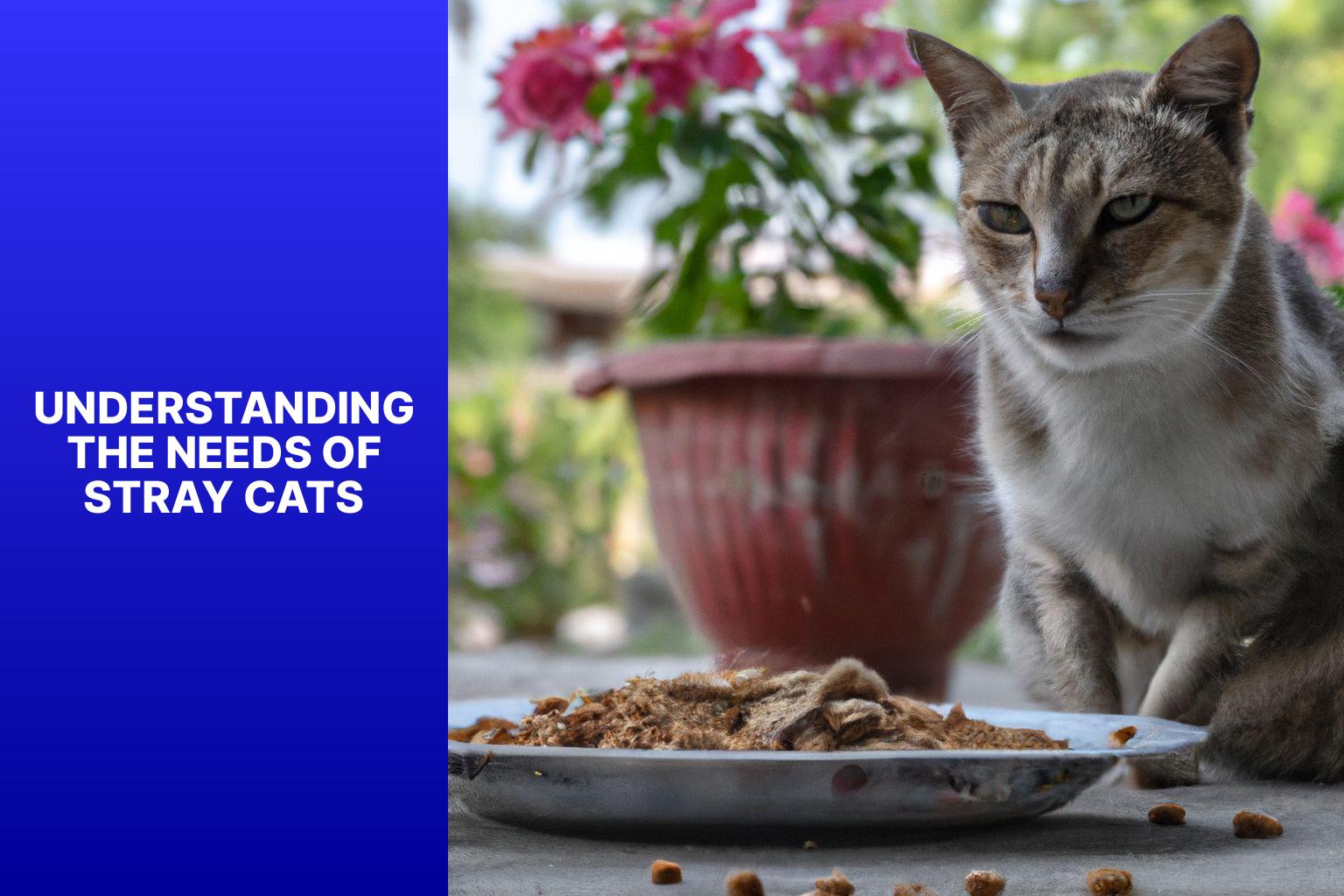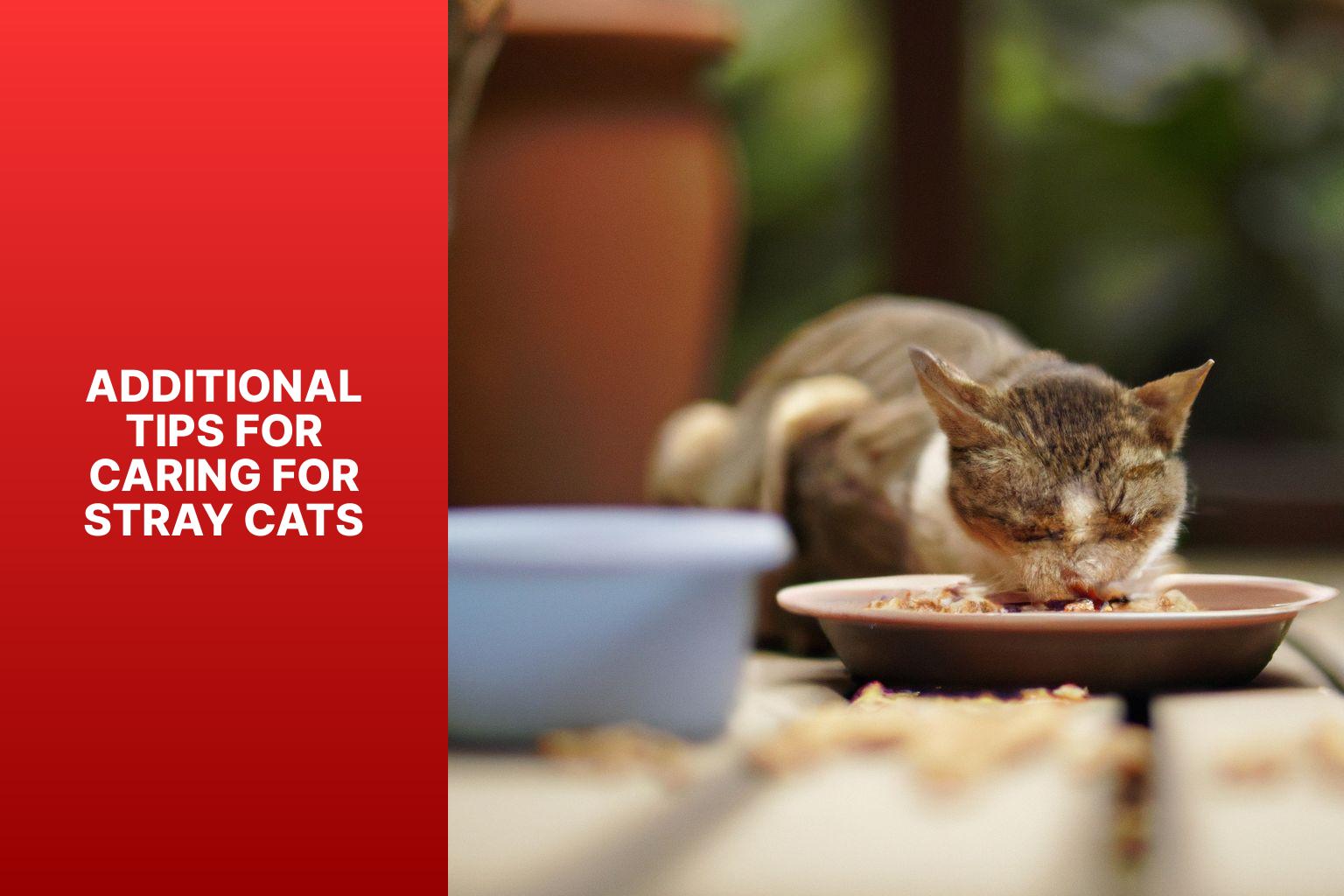Stray cats often face numerous challenges, and providing them with proper nutrition is crucial for their health and well-being. Understanding the needs of stray cats and knowing what to feed them is essential in helping them thrive.
When it comes to feeding stray cats, there are several options to consider. This includes dry cat food, wet cat food, and even raw or homemade cat food. Each option has its benefits and drawbacks, so it’s important to choose the one that suits your circumstances and the needs of the stray cat.
There are also important considerations to keep in mind when feeding stray cats. These include providing fresh water, establishing a feeding schedule and appropriate portion sizes, and socializing with the cats to create trust. Building a relationship with the stray cat is vital to their long-term well-being.
There are certain foods that should be avoided when feeding stray cats. This includes toxic foods for cats, such as chocolate, onions, and garlic, as well as spoiled or moldy food that can cause health issues.
In addition to feeding, there are additional tips for caring for stray cats. This includes spaying or neutering them to prevent overpopulation, providing shelter and safety in the form of warm, dry spaces, and seeking veterinary care when necessary.
By understanding the needs of stray cats and taking appropriate steps to provide them with proper nutrition and care, we can make a positive impact on their lives and help them lead healthier and happier lives.
Key takeaway:
- Understanding the Needs of Stray Cats: Stray cats face various challenges and require special care and attention.
- What to Feed a Stray Cat: Dry cat food, wet cat food, and raw or homemade cat food are suitable options for feeding stray cats depending on their nutritional needs and preferences.
- Considerations for Feeding Stray Cats: Providing fresh water, establishing a feeding schedule and portion control, and building trust with stray cats are important factors to consider when feeding them.
Understanding the Needs of Stray Cats
Photo Credits: Www.Catcornerblog.Com by Brian Baker
In 2015, Sarah noticed a stray cat in her neighborhood. Understanding the needs of stray cats, she provided food, water, and shelter for the cat. Over time, Sarah gained Luna’s trust through gentle interactions and veterinary care. Luna now lives a happy and healthy life in a forever home, thanks to Sarah’s understanding of the needs of stray cats and her dedication to helping them.
What Are the Challenges Faced by Stray Cats?
Stray cats face numerous challenges in their daily lives. One of the primary challenges is the lack of food. These cats struggle to find enough sustenance, which often leads to malnutrition and hunger.
Another significant challenge is that stray cats are constantly exposed to harsh weather conditions. Without proper shelter, they endure extreme temperatures, making them highly susceptible to health issues such as heat strokes and hypothermia.
Furthermore, stray cats are more prone to diseases and infections. This is due to their unhygienic environments and constant exposure to diseased animals.
These cats lack access to veterinary care, which means they go untreated for injuries and illnesses.
The challenges faced by stray cats are exacerbated by human neglect and abuse. Sadly, these cats often experience neglect, abuse, and intentional harm from humans, making their lives even more challenging and dangerous.
To address these challenges, it is essential to support organizations that focus on stray cat rescue and rehabilitation. Donating, volunteering, or fostering can make a real difference in their lives and provide them with a chance at a better future.
What Should You Feed a Stray Cat?
When it comes to feeding a stray cat, the question arises: what should you feed them? In this section, we will uncover the different options available. From dry cat food to wet cat food, and even raw or homemade cat food, we’ll explore the choices and what each sub-section has to offer. So, whether you’re concerned about their nutritional needs or want to provide a tasty meal, we’ve got you covered with all the information you need to make the right feeding choice for a stray cat.
Dry Cat Food
When it comes to feeding stray cats, dry cat food is popular. Consider the following when choosing and feeding dry cat food:
- Nutritional balance: Choose a dry cat food that meets cats’ nutritional needs. It should contain protein, fats, carbohydrates, vitamins, and minerals.
- Age-specific formulas: Consider the cat’s age. Different dry cat food formulas are available for kittens, adult cats, and senior cats. Choose one that aligns with the cat’s life stage.
- Quality ingredients: Check the ingredient list for high-quality ingredients. Look for real meat as the primary ingredient and avoid fillers or artificial additives.
- Portion sizes: Follow the feeding guidelines on the packaging. Adjust the amount based on the cat’s size, activity level, and health.
- Proper storage: Store dry cat food in a cool and dry place to maintain freshness and nutritional value. Seal the packaging tightly to prevent moisture and pests.
Pro-tip: Provide fresh water alongside dry cat food to prevent dehydration. Cats need access to clean water for their wellbeing.
Wet Cat Food
When it comes to feeding stray cats, one excellent option is wet cat food. There are several reasons why wet cat food is a great choice:
1. High moisture content: Wet cat food helps to keep cats hydrated, which is especially important for strays that do not have access to clean water.
2. Nutritional value: Wet cat food provides essential nutrients for optimal health, including proteins, fats, carbohydrates, vitamins, and minerals.
3. Easy to eat: Stray cats with dental problems or elderly cats may struggle with dry food, but wet cat food is soft and easy for them to eat.
4. Palatability: Cats are often more attracted to the texture and aroma of wet cat food, making it particularly beneficial for picky eaters or cats with reduced appetites.
In summary, wet cat food is a highly recommended choice when feeding stray cats. It offers the benefits of high moisture content, nutritional value, ease of eating, and palatability.
Raw or Homemade Cat Food
To provide a balanced diet for stray cats, raw or homemade cat food is a viable option. Here is a table of suitable ingredients for preparing raw or homemade cat food:
| Protein | Chicken | Beef | Turkey |
| Fruits and Vegetables | Pumpkin | Carrots | Sweet potatoes |
| Supplements | Taurine | Fish oil | Cod liver oil |
| Grains | Rice | Quinoa | Millet |
When preparing raw or homemade cat food, cook the proteins without bones to prevent choking hazards or health risks. Also, consult with a veterinarian to ensure the cat’s nutritional needs are met and follow proper food safety guidelines.
Feeding cats raw or homemade food offers several benefits, including higher moisture content, increased nutrient availability, and potential allergen avoidance. It is essential to balance the diet properly and meet all nutritional requirements.
Remember, every cat is unique, and their dietary needs may vary. Regularly consult with a veterinarian to monitor their health and make necessary diet adjustments. By providing raw or homemade cat food, you can contribute to the well-being and overall health of stray cats.
Considerations for Feeding Stray Cats
Feeding stray cats requires careful consideration to ensure their well-being. In this section, we will explore the essential factors to keep in mind when feeding these furry friends. From providing fresh water to establishing a feeding schedule and appropriate portions, we’ll cover all the necessary steps to meet their nutritional needs. We’ll delve into the importance of socializing and building trust with stray cats, fostering a healthier and happier relationship with them.
Providing Fresh Water
When caring for stray cats, providing fresh water is crucial for their health and well-being. Here are steps to ensure they have clean and safe water:
- Place multiple water bowls in accessible locations, such as near their feeding area or shelter.
- Check the water bowls daily and refill them with fresh water as needed.
- Regularly scrub the bowls to prevent bacteria buildup. Use mild dish soap and rinse thoroughly.
- During hot weather or if the water bowls are in direct sunlight, consider using shaded bowls or adding ice cubes to keep the water cool.
- Securely place the water bowls to prevent tipping or spilling.
- If you live in an area with extreme weather conditions, such as freezing temperatures, provide heated water bowls or replace the water frequently to prevent freezing.
Providing fresh water for stray cats helps keep them hydrated and maintain their overall health. It is a simple yet impactful way to show kindness and care for these vulnerable animals.
I remember finding a stray cat in my neighborhood. It looked tired and dehydrated, so I filled a bowl with fresh water and placed it near where the cat often stayed. To my surprise, the cat immediately approached and cautiously started drinking the water. It seemed relieved to find a source of hydration. Over time, as I continued to provide fresh water, the cat became more trusting and eventually let me approach and pet it. Ensuring access to fresh water not only quenched the cat’s thirst but also fostered a bond of trust between us.
Feeding Schedule and Portions
When feeding stray cats, establish a feeding schedule and provide appropriate portions for their health and well-being.
- Feeding schedule: Establish regular feeding times, ideally twice a day. This helps cats establish a routine and allows for easy monitoring of food intake.
- Portions: Provide about 4-6 ounces of wet food or 1/4 to 1/2 cup of dry food per day, depending on the cat’s size and activity level. Split the portion into meals throughout the day to prevent overeating.
- Monitoring: Adjust portions based on the cats’ eating habits. Increase portion size if they consistently leave food behind or appear hungry, and decrease portion size if they consistently overeat and become overweight.
- Water availability: Along with a feeding schedule, always provide fresh water for the stray cats. Place bowls of water in easily accessible locations to encourage hydration.
- Observing behavior: Pay attention to how cats respond and behave during meal times. This can help identify any appetite changes or issues that require veterinary attention.
By following a feeding schedule and providing appropriate portions, you ensure stray cats receive the nourishment they need for their health and well-being.
Socializing and Creating Trust
Spend time regularly socializing and creating trust with stray cats to help them become comfortable and familiar with your presence. Approach cats calmly and slowly to avoid scaring them. Use positive reinforcement by rewarding cats with treats or praises when they show signs of trust. Respect their personal space and avoid forcing physical contact if they are not ready. Provide hiding spots like cozy beds or small boxes for cats to retreat to if they feel anxious or threatened. Establish a consistent routine for feeding and care. Building trust takes time, especially for stray cats that may have had negative experiences with humans in the past, so patience and understanding are key.
What Foods Should You Avoid Feeding Stray Cats?
When it comes to feeding stray cats, it’s crucial to be mindful about what foods to avoid. In this section, we’ll dig into the potential dangers that certain foods pose to these feline friends. From toxic foods for cats to the risks of feeding them spoiled or moldy food, we’ll uncover key information that every cat lover should be aware of. So, let’s dive in and ensure these furry companions stay healthy and well-nourished!
Toxic Foods for Cats
Awareness of toxic foods for cats is crucial when feeding stray cats. Here are some examples:
- Onions and garlic: These foods damage a cat’s red blood cells and can lead to anemia.
- Chocolate: It contains theobromine, which is toxic to cats and can cause vomiting, diarrhea, and heart problems.
- Grapes and raisins: Even small amounts can cause kidney failure in cats.
- Alcohol: Cats are more sensitive to alcohol than humans, and even small amounts can be dangerous and potentially fatal.
- Caffeine: Foods and drinks containing caffeine, like coffee and tea, can cause restlessness, rapid breathing, and cardiac issues in cats.
- Dairy products: While small amounts are usually okay, many cats are lactose intolerant and can have digestive upset if they consume too much.
If a stray cat has ingested any of these toxic foods, immediate veterinary care is important. Providing a balanced diet of cat food formulated for their nutritional needs is the best way to ensure the health and well-being of stray cats.
Spoiled or Moldy Food
Spoiled or moldy food can be detrimental to stray cats and should be avoided.
- Eating spoiled or moldy food can lead to food poisoning in cats, resulting in symptoms such as vomiting, diarrhea, and abdominal pain.
- Moldy food may contain toxins that are harmful to cats and can cause serious illness or death.
- Feeding stray cats spoiled or moldy food can compromise their immune system, making them more prone to illnesses and infections.
- Prior to offering food to stray cats, it is crucial to inspect for signs of spoilage or mold.
- If the food has an unusual odor, abnormal texture, or visible mold growth, it should be discarded immediately.
- Do not assume that stray cats will consume anything, including spoiled food. They deserve fresh and safe meals, just like any other cat.
- Always opt for fresh and uncontaminated food when feeding stray cats to ensure their health and well-being.
Additional Tips for Caring for Stray Cats
Photo Credits: Www.Catcornerblog.Com by Stephen Campbell
Looking to provide the best care for those furry little wanderers? This section is packed with valuable tips to go the extra mile in caring for stray cats. From understanding the importance of spaying or neutering to ensuring they have a safe and cozy shelter, we’ve got you covered. Plus, we’ll dive into the crucial aspect of seeking veterinary care, because these little creatures deserve all the love and attention they can get. So, let’s dive right in and discover how to make a difference in the lives of stray cats!
Spaying or Neutering
Spaying or neutering stray cats is imperative for their overall well-being and effective population control. By undergoing this procedure, it helps prevent the occurrence of unwanted litters, ultimately addressing the issue of overpopulation among strays.
Moreover, spaying or neutering also plays a crucial role in preventing reproductive cancers and infections, ensuring the longevity and health of these feline creatures.
It significantly diminishes undesirable behaviors such as roaming, fighting, and urine spraying. It is highly recommended to have spaying or neutering carried out by a qualified veterinarian.
Typically, this procedure is advised when the cat reaches approximately 6 months of age, considering the cat’s health and individual development.
It is worth mentioning that spaying or neutering a stray cat may necessitate the use of trapping methods, so seeking professional advice and assistance is strongly advised.
By taking the initiative to spay or neuter stray cats, you not only contribute to their improved health, but also actively participate in the cause of population control. This step is essential in enhancing the overall welfare of stray cats, reducing the adversities they experience while living on the streets.
Providing Shelter and Safety
Providing shelter and safety for stray cats is crucial. Here are some important considerations:
1. Outdoor shelters: Offering a safe and secure shelter is essential to protect stray cats from harsh weather and predators. Sturdy cat houses or insulated wooden shelters are recommended.
2. Warm bedding: Ensure the shelter provides warmth during colder months by placing blankets, straw, or heated pads. This helps prevent hypothermia and keeps the cats comfortable.
3. Feeding and shelter area separation: It is important to create a separate area for feeding, keeping it away from the sleeping and shelter space. This ensures cleanliness and reduces the risk of attracting pests.
4. Safe surroundings: Prioritize inspecting the outdoor area for potential dangers such as busy roads, toxic plants, or hazards. Selecting a quiet and peaceful area minimizes stress for the cats.
5. Vet check-ups: Regular veterinary care is crucial. Provide necessary vaccinations, flea and tick treatments, and deworming to maintain overall health and prevent disease transmission.
By implementing these measures, you can provide the necessary shelter and safety for stray cats, ensuring their well-being in the outdoor environment.
Seeking Veterinary Care
Seeking Veterinary Care for stray cats is crucial for their health and well-being. Take them to a veterinarian as soon as possible for proper medical attention and care.
Veterinary care can involve vaccinations for diseases, deworming to eliminate parasites, and medical examinations to detect underlying health issues. It is also important to spay or neuter them to control the stray cat population.
When seeking veterinary care, find a reputable veterinarian experienced in working with stray cats. They will provide necessary treatments and ensure the cats receive the best care.
One true story of seeking veterinary care for a stray cat involved finding a cat with a severe leg injury. They took it to a veterinarian who assessed and performed the necessary surgery to repair the leg. With proper care, the cat recovered and found a loving forever home. This story highlights the importance of seeking veterinary care for stray cats.
Remember, seeking veterinary care for stray cats is essential for their health and well-being. Providing necessary medical attention improves their quality of life and gives them a chance for a brighter future.
Some Facts About What To Feed a Stray Cat:
- ✅ Feeding stray cats can be more involved than just leaving out a dish of dry kibble or canned food. (Source: The Spruce Pets)
- ✅ Most adult cats eat around 5.5 ounces of canned food and 2 ounces of dry food per day. (Source: The Spruce Pets)
- ✅ Kittens may require more food and should be fed kitten-specific food. (Source: The Spruce Pets)
- ✅ In the summer, canned food may spoil more rapidly, so adding extra water can help prevent it from drying out. (Source: The Spruce Pets)
- ✅ Uneaten dry food should be picked up after 30-45 minutes to prevent spoilage and deter wildlife and bugs. (Source: The Spruce Pets)







